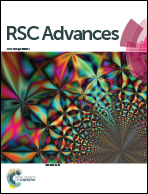A new mechanism for allylic alcohol isomerization involving ruthenium nanoparticles as a ‘true catalyst’ generated through the self-assembly of supramolecular triruthenium clusters
Abstract
The primary objective of this study is to determine the ‘true catalyst’ in an allylic alcohol isomerization reaction involving μ3-oxo-triruthenium(III) acetate [Ru3O(OCOCH3)6(H2O)3][OCOCH3] as catalyst. This ruthenium-complex was previously presumed to act as a homogeneous catalyst. However, we have confirmed the heterogeneous nature of this catalytic reaction that proceeds through in situ-formed metallic nanoparticles. A new, five-step mechanism, where ruthenium nanoparticles are generated from the supramolecular triruthenium clusters during the reaction and guided the progress of the reaction, has been discovered. In this model, a stepwise reduction of ruthenium-centers within the complex is considered generating ruthenium nanoparticles during the reaction and those steps play a key role for the optimization process. Three autocatalytic steps have been proposed to obtain the best fitted profile for the reaction. The ‘true catalyst’ of the reaction has been identified as Ru0 nanoparticles having a certain size and geometry (described as ‘C’). In addition, the smaller sized particles (B) present in the reaction mixture are also believed to show some catalytic activity.


 Please wait while we load your content...
Please wait while we load your content...